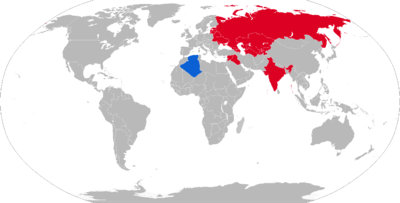R-40 (missile)
The Bisnovat (later Molniya then Vympel) R-40 (NATO reporting name AA-6 'Acrid') is a long-range air-to-air missile developed in the 1960s by the Soviet Union specifically for the MiG-25P interceptor, but can also be carried by the later MiG-31. It is the largest air-to-air missile in the world to ever go into production.
| R-40 AA-6 Acrid | |
|---|---|
 | |
| Type | Heavy Air-to-air missile |
| Place of origin | Soviet Union |
| Service history | |
| In service | 1970–present |
| Used by | Soviet Union, Syria, Iraq |
| Wars | Iran–Iraq War, Gulf War, Operation Southern Watch |
| Production history | |
| Designer | OKB-4 MR Bisnovatyi |
| Designed | 1959 |
| Produced | 1960s–1995 |
| Variants | R-40R / R-40T, R-40RD / R-40TD, R-40RD1 / R-40TD1 (radar and IR models) |
| Specifications (R-40RD) | |
| Mass | 475 kg (1,047 lb) |
| Length | 6.29 m (20 ft 8 in)(radar guided) - 5.91 m (19 ft 5 in) (IR guided)[1] |
| Diameter | 0.31 m (12 in) |
| Warhead | blast fragmentation |
| Warhead weight | 38–100 kg (84–220 lb) |
Detonation mechanism | Radar and active laser fuzes |
| Engine | solid-propellant rocket motor |
| Wingspan | 1.45 m (4 ft 9 in) |
Operational range | 50–80 km (31–50 mi)[2] |
| Maximum speed | Mach 2.2-4.5[3] |
Guidance system | Semi-active radar homing (R-40RD) Infrared homing (R-40TD) |
Launch platform | MiG-25, MiG-31 |
Development
The development of the Mach 3+ North American XB-70 Valkyrie threatened to make the entire interceptor and missile force of the Voyska PVO obsolete at one stroke, thanks to its incredible speed and altitude performance. In order to counter this new threat, the MiG-25 was designed, but new air-to-air missiles were also required to enable the MiG-25 to engage its intended targets at the high speeds and altitudes dictated by the requirements. The Bisnovat design bureau began development of the long-range air-to-air missile in 1962. The resulting R-40 was initially matched with the Smerch-A ("Tornado-A") radar of the MiG-25. It was built in semi-active radar homing (R-40R) and Infrared homing (R-40T) versions.[4]
In order to guarantee a kill at such high speeds and in the thin air, a large warhead was needed in order to have a sufficient blast effect. Large control fins were required to give the missile enough maneuvrability at high altitude. All this necessitated a very large missile and as a result, the R-40 is the largest air-to-air missile to ever enter production. It is slightly larger than the MIM-23 Hawk surface-to-air missile.
Following the defection of Soviet Air Defence Forces pilot Viktor Belenko in 1976 and the compromising of the MiG-25P's systems and the associated R-40s, Vympel developed an improved version of the missile with a better infrared countermeasures (IRCM) resistance and more sensitive seekers. The upgraded missiles were designated with the suffix -D (for 'dorabotannye', "finalized"). Later -D1 versions were also developed.
Production of the R-40 ended in 1991, but it remains in limited service arming surviving MiG-25 and some MiG-31 interceptors.
Combat history
In Soviet service, the R-40 was never fired in anger. Standard PVO procedure was to fire a 2-missile salvo at a target; 1 heat-seeking R-40T missile followed by a SARH R-40R, in order to avoid the possibility of the heat-seeking missile locking-on to the radar-guided missile.
As the MiG-25 has been exported to various states in the Middle East, the R-40 has been used in combat by Iraq and probably by Syria and Libya too. Author Tom Cooper claims that Syrian Air Force achieved an air victory on 29 June 1981 when Syrian MiG-25PD ( unit 1 FIS SAF ) shot down an Israeli F-15.[5] This has not been confirmed.
A declassified document of the CIA reports that in the first night of Desert Storm, on 17 January 1991, Scott Speicher's F/A-18C was shot down by an R-40R fired from an Iraqi MiG-25.[6]
On 30 January 1991 a IRAF MiG-25 damaged a USAF F-15C by a R-40 missile in Sammura air battle. However Iraq claimed and later confirmed that the F-15 was shot down and fell in Saudi Arabia after a bedouin smuggler found wreckage but USAF debunks these claims.
Operators

Current operators
Former operators

.svg.png)
- Retired. 660 missiles originally delivered.
.svg.png)


- Passed on to successor states.
Notes
- "Missile analysis: AA-6 Acrid" (PDF). FlightGlobal. Retrieved 4 February 2019.
- "Р-40 (ТД/ТР)". Archived from the original on 19 August 2010. Retrieved 5 August 2015.
- "Р-40 (AA-6 ACRID) - MilitaryRussia.Ru — отечественная военная техника (после 1945г.)". militaryrussia.ru.
- "AA-6 ACRID R-40". GlobalSecurity.org. Retrieved 4 February 2019.
- "acig".
- "Fixed Wing Coalition aircraft attrition in Desert Storm". Archived from the original on 11 November 2001. Retrieved 27 December 2019.
References
- Gordon, Yefim (2004). Soviet/Russian Aircraft Weapons Since World War Two. Hinckley, England: Midland Publishing. ISBN 1-85780-188-1.